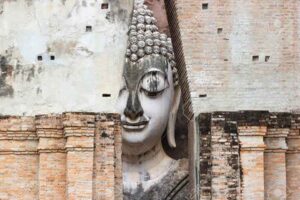In Sanskrit Mandala means ‘Circle’ or ‘discoid object’. Mandalas are objects of devotion in Hindusim and in Buddhism (Vajrayana Buddhism) and they are also used in Jainism. They can be painted on paper, wood, stone, cloth or even on a wall. In some traditions, they can be reproduced in ephemeral material such as butter or coloured sand. In some traditions like Tibetan Buddhism, the role of this art form is so strong that it could become an architectural structure and even whole temples may be built as giant mandalas.
The methods used in creating mandalas are very precise and merged with different rituals including the chantings of sacred formulas. It may be based on or include a variety of geometric shapes using patterns that have evolved from different symbols.
Mandala Origin
Through meditation and following a path of thought and action, Siddhartha Gautama, the founder of Buddhism, attained enlightenment, freeing himself from the cycle of death and rebirth. He taught this path to his followers who still practice these principles today.
As Buddhist monks traveled the Silk Road, a major trade route through Asia, they brought Buddhism to many other lands. They carried mandalas with them and brought the practice of creating these works of art to other parts of Asia. The earliest evidence of this art dates to the first century B.C.E. but appeared in other regions, such as Tibet, China, and Japan by the fourth century. Although rooted in Buddhism, mandalas later became present in Hinduism, New Age Spirituality, and other religious practices.
Meaning of Mandala
While a finished mandala bears importance as a focus for meditative practice, the creation process remains equally important. There are three basic layers to a meaning. The outer meaning represents the divine form of the universe. The inner meaning creates a map to guide the mind to enlightenment. The secret meaning, however, remains between the artist and the creation as far as specific details. Overall, it represents a balance of body and mind infused with clarity. Did you know the meaning of shapes and colors used in Mandala ?
Uses of Mandala
In the many traditions where this art is used, there are different rites where the practitioner, at least metaphorically, establishes a dialogue with the symbol or deity at the core of the mandala by moving progressively from the outside towards the centre. Once within the centre, the practitioner connects with the central symbol or deity and he or she is able to perceive all manifestations as part of a single underlying whole and gets closer to the goal of enlightenment or perfect understanding.
The Vajrayana Buddhist school (Tantric Buddhism), has a very complex set of rituals. In order to help the disciples to gain enlightenment, they use a wide range of physical disciplines and tools including mandalas. This school believes that achieving enlightenment by traditional methods requires a very long time, even many lifetimes, while the methods used in Vajrayana can deliver the same result in just a single lifetime.
It is also used as home decor. In the present context, everyone likes the idea of this art including the child, adult, and the elderly people. The concept of mandalas is used in the different field. The some of the most used concept are listed below:
Curtain
Wall hanging
Wall painting
Beach mat or yoga mat
Stencil
Floor Pillow Covers
Cushion covers
Bedsheet
Tapestry


